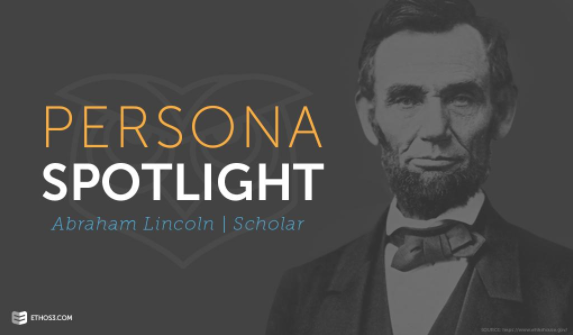By Scott Schwertly
I have been studying the public speaking styles of famous politicians and business leaders for over a decade. I have studied magnetic ones. I have studied terrible ones. But I have never seen someone as intriguing as the 16th President of the United States.
His mannerisms have been noted as awkward yet warm; his voice unpleasant yet profound; his thoughts clear yet argumentative; and his appearance as ungainly yet cool. Either way, he made a lasting impact on American politics and the world.
So how did he accomplish such an amazing feat? It all boils down to his presentation persona.
I’ll explain. For quite some time, my team and I have been working on a proprietary presentation assessment tool called Badge. Bottom line, one can take the Badge assessment and, within minutes, discover which one of 16 profiles fits them best. Without giving away all of our secret sauce, it examines every presenter in four major areas.
Here’s a breakdown of each those modules:
Module 1: Exploration – An Introduction
This quadrant captures everything about how one approaches the task of presentation preparation. It unpacks the level of seriousness with which an individual plans, researches, and organizes his or her thoughts.
Why It Matters
Exploration matters because it examines whether a speaker has researched and rehearsed, has the right message, and cares about the look and feel of his or her slides. In other words, it measures if the presenter is prepared to share a powerful narrative.
Module 2: Sharing – An Introduction
This quadrant measures one’s ability to share and deliver a compelling message. It covers charisma, confidence, humor, authenticity, and much more. It explores just how natural or awkward a person is in front of a room.
Why It Matters
It’s the presenter on stage. Is he or she confident? Conversational? Charismatic? Comfortable? All these elements matter when an individual is in front of a room.
Module 3: Response – An Introduction
Do people like or dislike the presenter once the presentation is over? This is what the Response quadrant attempts to discover. It unpacks just how well a person’s message is received and retained by the audience.
Why It Matters
Response is all about whether a speaker has a servant’s heart. Caring about the audience matters – and this quadrant will extract that reality.
Module 4: Durability – An Introduction
This quadrant is all about lifetime value. Does the content stand the test of time? Speeches that would score well here include Martin Luther King Jr.’s “I Have a Dream” or Franklin Delano Roosevelt’s Pearl Harbor address to the nation. Why? They continue to stand the test of time.
Why It Matters
Every great presentation or speech inspires, motivates, and even changes the world. Durability matters if a presenter wants to make a broad impact on the world and those around them.
How Does Lincoln Stack Up?
So how does Lincoln fit within these four main modules?
He was a Scholar – a presenter who is an always-curious learner informed by his own wisdom.
This implies that Lincoln scored high in Exploration and Durability and mid-low in Sharing and Response.
Exploration: Lincoln was known for the clearness of his logic. Every word was always carefully chosen. If you revisit the Gettysburg Address, you will find that, in 273 words, he changed the world utilizing groundbreaking concepts like “A government of the people, by the people, for the people” or his mention of ideologies like “equality.”
Sharing: President Lincoln was a tall man, standing at six feet four inches, with long arms and legs. His feet and hands were also large. As an end result, he always looked a bit awkward in front of a room. He also was considered a sad man with an intellectual face; in turn, not giving him amazing scores in the Sharing category.
Response: When we look back to the 1860s, we look at a man who made a radical difference on America and the world. However, he was not adored by every single citizen. As the leader of the Union during the Civil War, his words didn’t always resonate with the masses – including the Confederate south.
Durability: President Lincoln was a revolutionary. Plain and simple. His words and speeches changed our nation and the world forever. His speeches, letters, and proclamations challenged the status quo and pushed the American people past their comfort zones.
Abraham Lincoln was a powerful and thoughtful orator, which made him an incredible scholar. But what about you? You can find out your own presentation persona right now.
Here’s how:
- Go to ethos3.com/badge
- Take the Badge assessment (it only takes 10-12 minutes)
- Pick up a copy of What’s Your Presentation Persona? to learn about your profile
It’s that easy. Once you discover your profile, come back here and let me know how you scored. I would love to discuss.
 Scott Schwertly is the founder and CEO of Ethos3 and the creator of Badge, a proprietary presentation assessment tool that helps presenters discover and maximize their presentation style. He is also the author of two books: What’s Your Presentation Persona? and How to Be a Presentation God. If Scott is not working with his team building presentations or co-hosting his Presentation Scientists podcast, you will find him in the pool, on the bike, or on a long run since he is a 2x Ironman, 7x marathoner, and competitive triathlete.
Scott Schwertly is the founder and CEO of Ethos3 and the creator of Badge, a proprietary presentation assessment tool that helps presenters discover and maximize their presentation style. He is also the author of two books: What’s Your Presentation Persona? and How to Be a Presentation God. If Scott is not working with his team building presentations or co-hosting his Presentation Scientists podcast, you will find him in the pool, on the bike, or on a long run since he is a 2x Ironman, 7x marathoner, and competitive triathlete.









